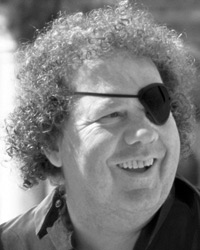Dale Chihuly
American artist (1941 - )

- || At The Bottom
1976 -- On a rainy night in England, a relatively unknown American glass artist named Dale Chihuly flew through the windshield of the car he was driving when it collided head-on with another vehicle. Not wearing a seatbelt, Chihuly was the only person harmed in the accident; he nearly died from blood loss, and lacerations to his face cut deeply into his left eye. When Chihuly regained consciousness, doctors informed him that he would never be able to see properly. Without both eyes, Chihuly's depth perception would be permanently altered, making it difficult for him to produce symmetrical glasswork -- and symmetry had been one of the most important aspects of glasswork since the Venetians revitalized the craft of glassblowing seven hundred years ago. Dale Chihuly was fortunate to survive the wreck, but his career faced a steep road ahead.
- || At The Top
1996 -- Dale Chihuly arrived in Venice, the birthplace of modern glassblowing, with fourteen chandeliers. The chandeliers had been produced in collaboration with scores of master glassblowers in Finland, Ireland, and Mexico and consisted of thousands of individual parts. Chihuly and his team placed the finished chandeliers throughout Venice, and the high definition film of the project turned Chihuly into one of the most well known American artists of the era. His work can now be found in virtually every significant art museum in the US as well as abroad, and various pieces of his are owned by patrons such as Queen Elizabeth II, Bill Gates, Elton John, and Bill Clinton among others. His traveling exhibitions draw audiences to museums who might never have visited otherwise, and he is credited with bringing glasswork from the world of crafts into the realm of high art. One journalist has described Chihuly as the general of a "Napoleonic marketing campaign" that has produced a luxury market for glass.
- || The Comeback
Chihuly returned to his art as quickly as he possibly could after the accident, covering his eye with a black eye patch that would one day become one of his defining features. Like most patients who suffer from eye injuries, Chihuly's brain compensated for the loss of depth perception, and he was able to regain some of it with time. His work was altered by the loss of his eye -- but in a way that few would have predicted. Rather than attempt to produce symmetrical glasswork, Chihuly embraced asymmetrical forms and began producing wildly creative new pieces that looked, in the words of one author, "like dinosaur eggs that had hatched and mutated into some organic form that seemed almost alive." Chihuly's accident allowed him the chance to see the world and his art differently and to imagine new possibilities for his work. In 1978, he earned his big break when the Renwick Gallery -- part of the Smithsonian Institution -- selected Chihuly for a solo show. Over the next decade, Chihuly developed a reputation as a relentless promoter of his own work, building up his small glassblowing shop into an immensely profitable conglomerate that produces, warehouses and ships thousands of pieces each year to museums and art collectors around the world. Though additional physical problems forced Chihuly to stop blowing glass himself in the late 1970s, he hired apprentices to put his vision into form and maintained control over the artistic process, likening himself to a film director or a dance choreographer.



